How to Create a Website Without Coding in 10 Simple Steps

Building a site can feel slow and costly, yet many teams now want a faster way to create a website without coding. The growing interest in creating a website without coding shows how much businesses value speed and simplicity. This MOR Software’s guide will walk you through the key steps and tools that help you launch a clear, modern website without needing technical skills.
What Does No-Code Mean In Web Development?
No-code websites, including tools similar to Microweber, let people build pages without knowing HTML, CSS, or JavaScript. This approach helps many teams create a website without coding in a simple and clear way. Today up to 84% of enterprises say they have adopted low code tools to reduce the strain on IT and speed up internal app delivery.
You can work with visual editors, ready-made blocks, and templates that guide you as you shape each page.
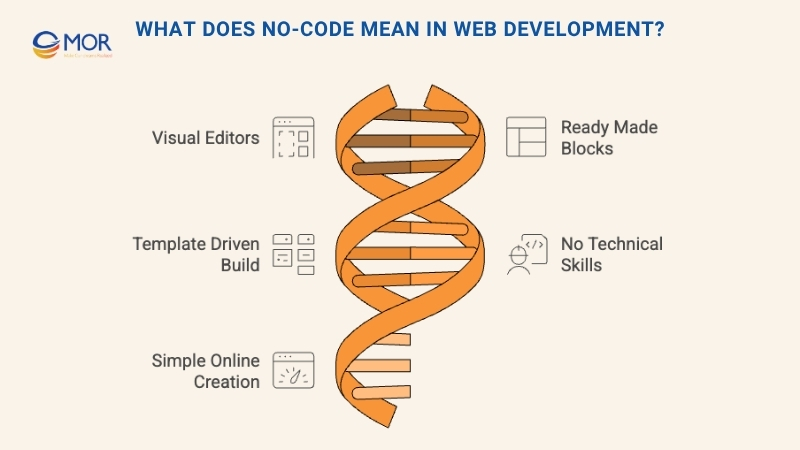
This gives people with no technical background a way to build online projects with ease, as long as they can get online. One study found that 70% of users without coding experience can master these tools in under a month.
>>> Let’s explore how agile web development can revolutionize your development process and ensure project success.
Why Choose A No-Code Approach?
No-code tools make web creation open to anyone with an idea. Their drag and drop setup and clear controls help people move fast as they test early versions of a project. This gives teams a simple path to shape prototypes or MVPs without writing code. It also supports those who want to create a website without coding and still keep a smooth workflow.
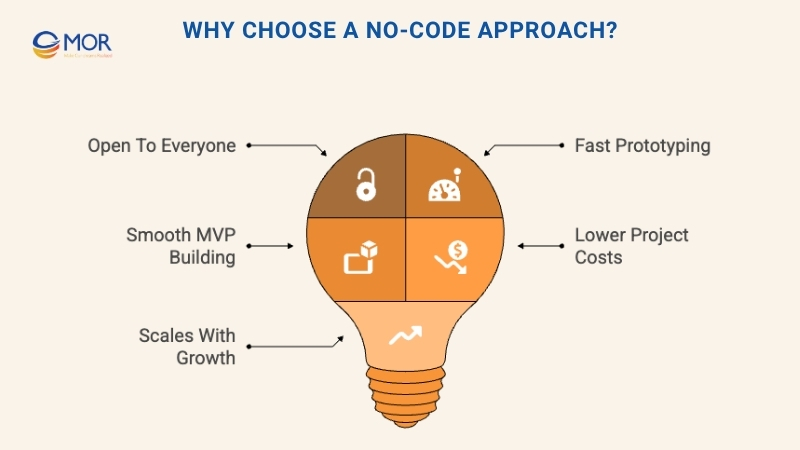
No-code also removes the need to hire a full development team for many basic projects, which helps founders and companies save money. Some reports show that no code platforms can cut development costs by 65% on average and make builds up to 90% faster than traditional coding. These platforms can grow with your work, so your site can expand as your audience increases.
Key Preparations Before You Create A Website Without Coding
Before you start working with no-code tools, take a moment to confirm that your idea is clear. This early step helps shape your plan for creating a website without coding.
- Look into the market and collect feedback from real users to check whether your website solves a real need for the people you want to reach.
- Review different no-code platforms. Study their pricing, tools, and options so you can choose the one that matches your goals.
- Think about how much design freedom each platform gives you. A clean and friendly design is important for any website that aims to keep visitors engaged.
Step-By-Step Guide To Create A Website Without Coding
In this section, we will walk you through each stage needed to create a website without coding in a clear and steady way. It keeps the process simple so you can turn your idea into a working site without technical stress.
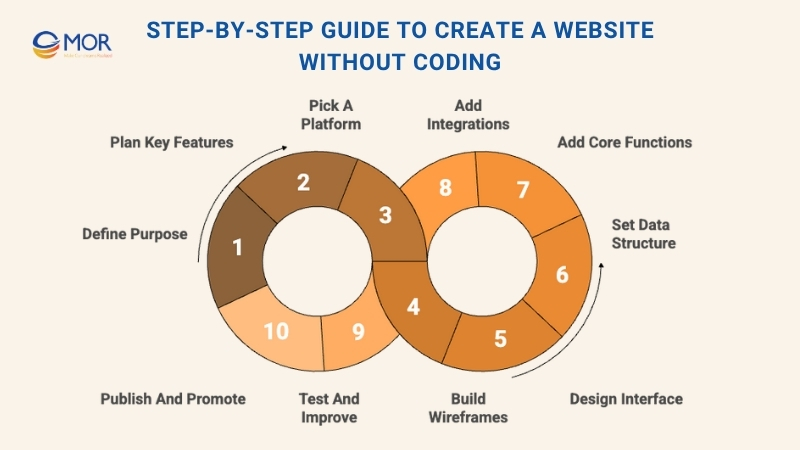
1. Define Your Website’s Purpose And Audience
The first step in shaping any strong website is knowing why it exists.
What issue will it address? Who are you building it for?
- What issue will it address?
- Who are you building it for?
Your answers will guide you through each stage of the work. Every layout choice and each function should support the main needs of your users while helping you create a website without coding in a focused and practical way.
2. Map Out The Features You Need
Once you understand the purpose of your site, turn that idea into a clear plan. List every function your website should have. Then sort these modern web development stack based on how important they are and how much they help your users.
Focus first on the core parts that make your site useful and different. Extra elements can come later, once the main structure is ready to support growth in a steady and organized way.
3. Select A No-Code Platform
There are many no-code platforms on the market today, and each one serves different needs. Well known choices include Bubble, Glide, Wix, and Webflow. Spend some time studying these tools so you understand what they can do.
Look at their pricing, learning curve, and the range of functions they provide. Check how active their communities are, since this support can help when you create a website without coding. Think about how complex your website will be and what level of technical comfort you already have before making a final decision.
4. Build Wireframes And A Prototype
Before you start building your pages, take a moment to picture how the whole website will look and move. A wireframe is a simple sketch of each screen. It shows where key elements sit and how people travel from one part of the site to another.

Many no-code tools include prototyping features that help you turn these sketches into a clickable model without writing code. This early version lets you test how the site feels and make changes before you spend more time creating a full build. It also supports a smoother path as you shape your website.
5. Design Your Website Interface
The first look of your site shapes how people feel about it. Your user interface is the part everyone sees, so keep it clear, friendly, and easy to follow. Aim for a layout that feels simple and supports each action your visitors want to take.
Use clear labels and keep the same style across every page so the flow feels natural. Most no-code platforms already include ready UI parts and templates, which makes this step faster. These tools help you build a clean and effective design without needing deep design skills.
6. Organize Your Data Structure
Data sits at the center of most websites. It includes the details your site collects and depends on to work well. Start by listing the types of information your site must handle, such as user accounts, product lists, or order records.
Most no-code platforms give you simple tools to build and manage a database. They let you set up fields, connect related items, and shape the structure your site needs. This step keeps everything clear and supports a stable and organized workflow.
7. Add Core Website Functions
This part shows how strong no-code tools can be. Use the drag and drop editor and the ready functions that come with the platform you picked. Link elements like buttons, text fields, and data blocks so each part of the site works the way you planned.
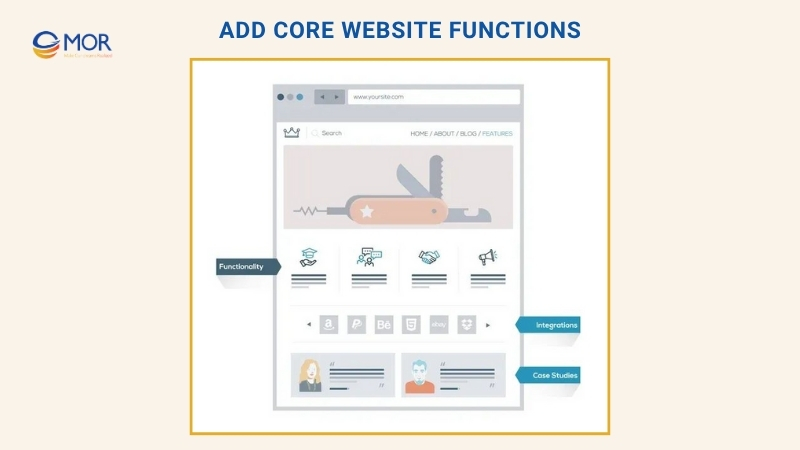
You don’t need coding skills for this stage. The visual tools let you set the logic and flow step by step, which makes it easier to create a website without coding and keep every action clear and consistent.
8. Add Integrations
You can make your website stronger by connecting it with outside services. Many no-code tools support links to payment systems, social platforms, and email tools. These connections help your site do more and give visitors a smoother, richer experience.
9. Test And Improve Your Website
Careful testing is important before you share your site with the public. Try it on different devices and browsers to confirm that everything works smoothly everywhere. This step helps you check how well each part performs.
Ask friends, family, or early testers for their thoughts. Their comments can show you what feels confusing or needs a small fix. Stay ready to adjust and polish your website based on what you learn from this feedback.
10. Publish And Promote Your Website
When you feel sure that your website is useful and easy to use, it is time to go live. Publish it through the hosting service in your no-code tool, or link a custom domain if you want a more professional look. This final step completes your effort to create a website without coding.
At the same time, start simple marketing activities to bring in visitors. Share your site through social channels, email, or any place your audience follows. This helps more people discover your new no-code creation.
>>> How do you choose the right Python frameworks for web development in 2025 when there are so many options? Which python framework is best for web development and what are the best practices to optimize your web development workflow?
Recommended No-Code Builders To Create A Website Without Coding
Many people search for the easiest no-code website builder when they want a simple starting point. The list below will give you a clear view of the most common options and what they can do.
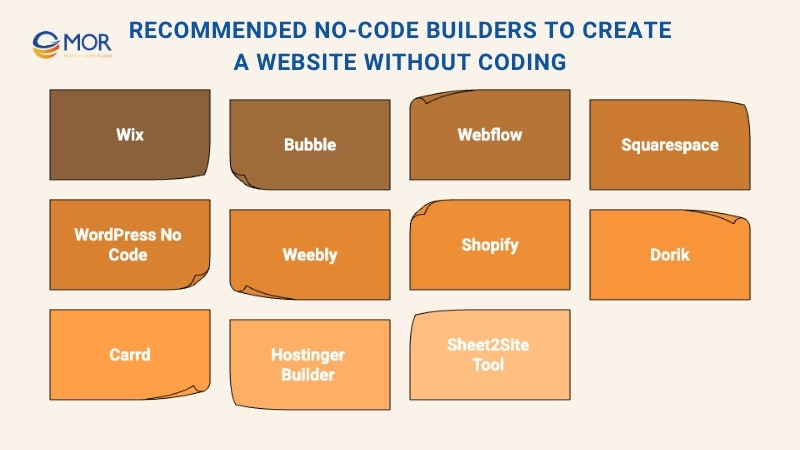
Wix
Wix is a cloud-based no-code builder that lets users shape websites without writing code. It provides a wide range of templates and add-ons that help you build a clean and responsive site.
Features
- Drag and drop page editor
- More than 900 design templates
- 24 or 7 customer support
- Basic SEO tools
Pros
- Simple to use and budget friendly
- Free plan available
- Strong security setup
Cons
- Free plan shows ads
- SEO tools feel old and limited
Bubble
Bubble is known as one of the more advanced no-code platforms on the market. It gives users wide control when building SaaS products, online markets, or social platforms without writing code. This can be helpful for teams that want to create a website without coding but still need complex features.
Features
- Flexible and customizable setup
- Drag and drop workflow automation builder
- Solid privacy controls
- More than 800 plug ins, including Google, Facebook, and Stripe
Pros
- Automatic backup system
- Smooth integration with billing tools like Braintree and Stripe
- Safe and reliable hosting and deployment
Cons
- Free users get fewer backup options
- Takes time to learn and master
Webflow
Webflow gives designers the freedom to build polished and custom websites without touching code. The platform also includes stable hosting that takes care of the technical setup for you.
Features
- Runs on Amazon Web Services
- No installs or manual updates needed
- Built in SEO tools
- Free to use until you launch your site
Pros
- Packed with useful functions
- Smooth to use with strong overall performance
- 24 or 7 customer support
- Advanced visual design tools
Cons
- The different plan options can be hard to understand
- The wide range of tools means it takes time to learn
Squarespace
Squarespace is a well known website builder that works well for creative users, including artists and photographers, or anyone who wants a clean and professional site.
Features
- Lets users migrate their site from another platform
- 24 or 7 customer support
- Built in site analytics
- Tools to create a polished portfolio
Pros
- Includes basic SEO tools
- Connects with major social, payment integration development, shipping, and marketing services
- Mobile friendly site layout
- Free logo creator
Cons
- The site editor can feel challenging at first
WordPress (No-Code Mode)
WordPress is still one of the most popular ways to build websites. Although it supports custom coding, you can also use it in a no-code style through plugins like Elementor or Divi. With more than 9,600 themes, the platform makes it simple to create a website without coding and publish content fast.
Features
- Drag and drop page builder
- Extra functions through themes and plugins
- Flexible design options
- Built in blog system
Pros
- Simple and familiar for most users
- Works well for small or large sites
- Access to more than 54,000 plugins
- Mobile friendly layouts
Cons
- Regular update requirements
- Can face security risks
- Some areas feel hard to move around in
Weebly
Weebly is a no-code builder with a simple drag and drop setup, flexible design choices, and helpful tools for online stores. It also supports shipping, order control, and payment handling, which makes it useful for small eCommerce teams that want to create a website without coding.
Features
- Part of the Square product suite, which gives customers many payment options
- 24 or 7 support through chat, email, and phone
- Mobile version available
Pros
- Allows video backgrounds to make pages feel more lively
- Built in autosave feature
Cons
- The platform sometimes has small glitches
- SEO tools feel limited
Shopify
Shopify is an eCommerce platform built for both physical stores and online shops. It gives users a simple setup, which helps many small teams launch products quickly even when they want to create a website without coding.
Features
- More than 70 professional themes
- Optional access to CSS and HTML for deeper edits
- PCI compliant payments with 3D secure support
- Built in Google Analytics connection
Pros
- 24 or 7 customer support
- Fast system updates
- Email forwarding included
Cons
- SEO tools need more depth
- Limited room for heavy customization
Dorik
Dorik is a simple and flexible no-code builder that includes more than 130 UI parts and many ready templates. It helps users create responsive sites with as many pages as they need. This makes it a handy choice for anyone who wants to create a website without coding and still keep things clean and organized.
Features
- Stable hosting with a built in CDN
- Free SSL certificate from Let’s Encrypt
- Easy domain connection
- Supports payments through Gumroad, Stripe, and PayPal
Pros
- Simple to work with and very flexible
- Large collection of templates and UI pieces
Cons
- Fewer advanced functions compared to larger builders
Carrd
Carrd is a lightweight builder made for single page websites. It is clean, responsive, and free to start. Many beginners choose it because it keeps the setup simple and avoids complex layouts, which also helps new users create a website without coding in a quick way.
Features
- Create up to three sites on one account
- No Carrd branding in the footer
- Google Analytics support
Pros
- Very simple and friendly for new users
- MailChimp connection included
- Free subdomain available
Cons
- Fewer advanced tools
- No support for blogs or online stores
Hostinger Website Builder
Hostinger Website Builder is a beginner friendly tool that uses AI as a service to help you build a clean and fast website. It is designed to support users who want to create a website without coding and still aim for strong performance.
The platform includes hundreds of responsive themes for both personal and business use. Its drag and drop editor lets you adjust each design element so your site looks the way you want.
Features
- Drag and drop editor with a precise grid system
- More than 100 mobile friendly templates
- AI tools for content, logos, and heatmaps
- Free lifetime SSL certificates
- Built in eCommerce system
- Marketing integrations
- Basic SEO tools
- Many payment options
- Automatic backups with simple restore
Pros
- Free hosting included
- Strong value for the price
- 24 or 7 customer support through live chat and tickets
- 30 day money back guarantee
Cons
- No free plan
- Limited flexibility for developers
Sheet2Site
Sheet2Site is a smart no-code builder that turns a single Google Sheet into a complete website filled with text, images, filters, and links. It gives users a fast way to create a website without coding while keeping the setup simple.
Features
- Free hosting included
- Basic SEO management tools
- Built in MailChimp and Google Analytics support
Pros
- Easy to make grid style layouts
- Updates itself when you change the Google Sheet
- 30 day money back guarantee
Cons
- No free plan available
- Very simple learning curve
How To Choose The Right No-Code Builder For Beginners?
A strong website builder should handle the technical work in the background and still feel smooth for the person creating the site. Below are the main points you should check when you plan to create a website without coding.
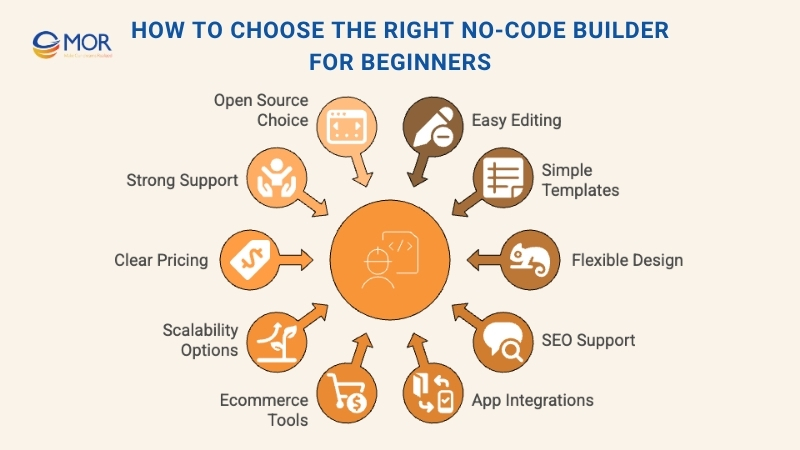
Ease Of Use:
- Drag and drop editing: This visual setup lets you place items on your page without writing code.
- Pre designed templates: Ready layouts help you start fast and give your site a clean look.
Design Flexibility:
- Customization options: A good builder lets you adjust colors, fonts, layouts, and images so your brand stays consistent.
- Mobile responsiveness: Your site should work well on phones, tablets, and desktops.
Built In Functionality:
- SEO tools: Basic SEO support helps your site appear in search results.
- App integrations: You can add forms, email tools, and analytics to improve your site.
- Ecommerce support: If you want to sell online, look for product pages, carts, and secure payments.
Other Factors:
- Scalability: The platform should support more traffic and new features as your site grows.
- Pricing: Each builder has different plans, so match the cost to your goals.
- Customer support: Good support helps you fix issues quickly.
- no-code website builder open source: Some users may want an open source option for more control and freedom when setting up a long term project.
When you keep these points in mind, it becomes easier to pick a builder that fits your needs and helps you create a site that shows your style and works well for visitors.
For enterprises with broader requirements, no-code tools may fall short once the system grows or needs deeper customization. This is where MOR Software JSC, a web development outsourcing company, can support your team. We handle complex development work, build scalable architectures, and extend features that no-code platforms cannot deliver. Businesses often start with a simple no-code site, then work with us when they are ready for a more advanced, secure, and fully tailored solution.
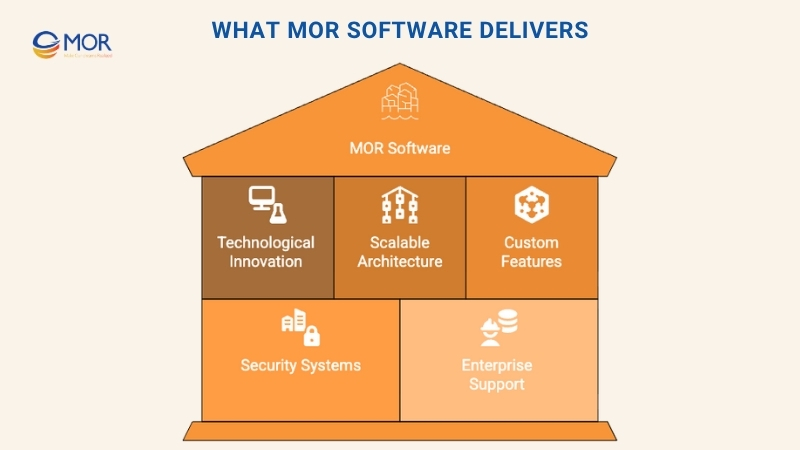
If your roadmap goes beyond what no-code can do, contact us and let our team help you move to the next stage.
Conclusion
Creating a site is much easier today, especially when you can create a website without coding and move fast from idea to launch. No-code tools give you a solid start, yet many teams later need deeper functions or a system built for long term growth. This is where MOR Software supports you with strong engineering and custom AI solutions. If you want a website that grows with your business, contact us and let our team help you build the next version of your platform.
MOR SOFTWARE
Frequently Asked Questions (FAQs)
Can I create a website without coding?
Yes, you can. Modern no-code builders let you design pages, add features, and publish your site using visual tools instead of programming. Drag-and-drop editors make the entire process approachable for beginners.
Is it possible to create a complex website without coding?
In many cases, yes. Advanced no-code platforms can handle multi-page sites, databases, workflows, and even automated actions. While extremely specialized systems may still need custom development, most business websites can be built without writing code.
Can ChatGPT help me build a website?
ChatGPT can assist by generating text, layout ideas, design recommendations, and even code snippets if you want to export them into a builder. With the right prompts, you can get guidance for each step of the process.
What is the easiest no-code website builder?
Beginners often find Wix and Hostinger Website Builder the simplest to use thanks to their intuitive editors. Platforms like Webflow or Framer offer more advanced design freedom but require a bit more practice.
How to create a website without coding for free?
Yes. Platforms like Google Sites, Carrd, and Wix’s free tier allow you to build and publish a basic website at no cost. Free plans usually include limitations, but they work well for simple personal or informational pages.
Which no-code website builder is best for beginners?
Squarespace and Wix consistently rank as beginner-friendly choices. They offer ready-made templates, simple controls, and a short learning curve, which makes them ideal for first-time website creators.
Do I need to buy hosting when creating a website without coding?
Most no-code builders include hosting in their plans. Once you publish your site, it stays online without requiring you to set up or manage a separate hosting provider.
Can I make an online store without coding?
Definitely. Tools like Shopify, Wix eCommerce, and Squarespace Commerce let you add products, accept payments, and manage orders without touching any code.
How long does it take to create a website without coding?
Simple websites can be completed in a few hours. More detailed sites with multiple pages, custom layouts, or integrations may take a few days, depending on how much content you prepare.
Will a no-code website look professional?
Yes. Templates, design blocks, and modern UI components make it easy to create a polished, professional-looking site even if you have no design background.
Can I customize my no-code website later?
You can update content, add sections, change layouts, or integrate new features at any time. Most builders let you adjust nearly everything without breaking your existing pages.
Can I earn money from a website built without coding?
Yes. You can monetize through ads, affiliate links, product sales, memberships, or sponsored content. As long as your website attracts engaged visitors, it can generate income regardless of how it was built.
Rate this article
0
over 5.0 based on 0 reviews
Your rating on this news:
Name
*Email
*Write your comment
*Send your comment
1